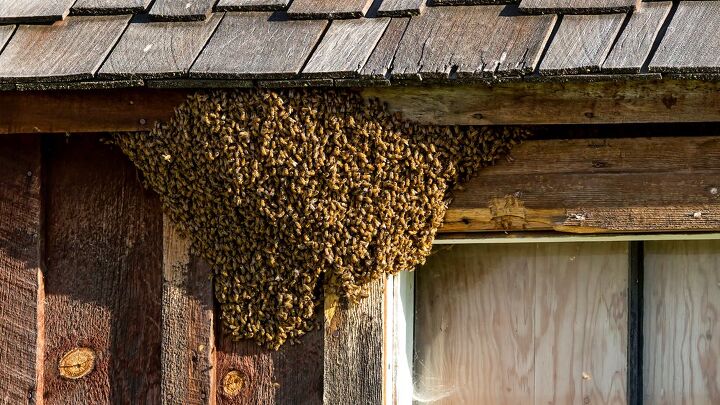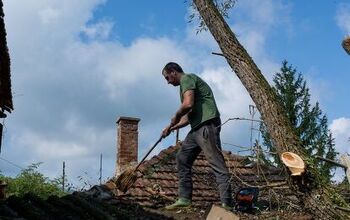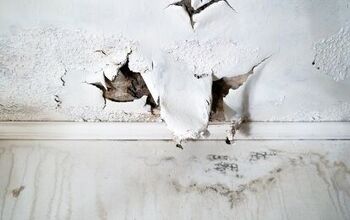Does Homeowners Insurance Cover Bee Removal?

Honeybees, even though they do great things for the environment, may cause a lot of harm in a short amount of time to your home. You could end up paying hundreds of dollars in repairs if bees are not eradicated or relocated immediately. So, who do you reach out to? Will homeowner’s insurance cover the cost to remove the bees?
The majority of homeowner’s insurance policies do not cover the cost of bee eradication or the cost of the damage bees cause. A bee infestation is considered a maintenance issue rather than a one-time problem. Because of this, homeowners insurance typically does not accept claims for bee removal or any damage that the bees cause.
Having a bee issue can be frustrating but also dangerous if you’re allergic to them. In this article, we will talk about the ins and outs of homeowners’ instances as it relates to bee removal and what you can do to solve the issue on your own.
Will Homeowners’ Insurance Cover Bee Removal?
It is uncommon that honeybees will cause thousands of dollars in damage to a person’s property since most homeowners will have honeybees removed quickly to prevent any further property damage.
Honeybees, and any bees for that matter, are classified as an insect infestation by insurance carriers. Bee removal and any accompanying repair costs are not covered by a homeowner’s insurance policy. This is because bees and other insects cause damage over time rather than causing immediate loss.
The insurance industry believes that if a honeybee infestation is severe enough to justify an insurance claim, it should have been treated and prevented far sooner. As a result, insurance does not cover the expense of bee removal or the cost of repairs. This is similar to homeowner’s insurance refusing to pay for damage caused by fleas, ants, or termites.
Your property may become uninsurable if the bee infestation is ignored unchecked for too long. This has only happened a few times to those who had major property and structural damage. Insurance firms have sent non-renewal notices. Until the infestation is eliminated and all repairs are performed, the property is considered uninsurable.
What Do You Do if You Have a Bee Infestation?
If you have a bee problem, you need to take the following steps:
- Determine the bee’s species. Is that a honeybee, wasp, hornet, or something else?
- Count the nests. Determine the number of nests and access points.
- Check how long the bees have been around. Calculate the length of time the bees have been in the area.
- Call a beekeeper or pest control. If you have a honeybee infestation, you should call a local beekeeper or a business that specializes in honeybee relocation. If you have a wasp, hornet, or another form of bee infestation, call a pest control firm in your area to safely remove the insects.
Does a Home Warranty Cover Bee Removal?
Many home warranty companies, unlike homeowner’s insurance, provide a limited kind of pest control coverage. What is covered by this coverage varies depending on the home warranty company and the region.
Honeybee infestations are neither covered nor protected by the majority of home warranties. Most pest management plans protect against cockroaches, earwigs, and house crickets, but not honeybees.
What Pests Are Covered By a Home Warranty?
The following is a list of pests that are usually covered by pest treatment coverage offered by most warranty companies:
- Moths
- Silverfish
- Scorpions
- Cockroaches
- Non-poisonous spiders
- Earwigs
- Paper Wasps
- House Ants
- Millipedes
- Centipedes
- House Crickets
How Much Does it Cost to Remove a Beehive?
A tiny honeybee colony will typically cost between $100 and $250 to remove and relocate. If found early, most beehive removals fall into this price range, and you’re unlikely to pay more than a few hundred dollars to have them securely removed.
The following are the major elements that will influence the cost of beehive removal or relocation:
- The size of the colony of bees
- The type of bee.
- The location of the hive.
- How tough is it to get to the beehive?
Swarm removal is the most straightforward and cost-effective method of beehive relocation. The larger the bee’s nest, especially if it’s inside walls and attics or high up, the more expensive it is to remove.
Furthermore, the cost of beehive removal usually does not cover any necessary repairs. Some beehive removal firms, on the other hand, do provide repair services.
Important note: If you want honeybees relocated, do not spray them. The bees cannot be relocated once they have been treated.
How Do You Permanently Remove a Beehive?
Everyone enjoys seeing a bee fly from one blossom to the next. However, beehives are terrifying because even a little mistake can have disastrous consequences.
To get rid of a beehive, it is recommended that you hire a professional beekeeper. A beekeeper is someone who keeps bees for the purpose of obtaining honey, beeswax, pollen, and fertilizing plants and vegetables. However, if you are unable to find anyone, there are a few things that you can do on your own.
Smoke
Smoke causes bees to shift their hive, which you can simply remove. Although burning sugar produces a lot of smoke, it can cause smoke damage if done indoors.
Indoors, enormous amounts of incense have been utilized successfully. Bees will shift their colony if they are constantly exposed to smoke. Remove the hive from your building or apartment once the bees have left.
Soap and water
Soap and water is a good way to get rid of a hive of bees. Soap dissolves the waxy covering of the bees and keeps them from drowning. However, if the beehives are enormous or out of your control, this procedure should be used with caution and professional guidance.
Kill the bees
Unless beehive removal is difficult, this method is not suggested. To kill honey bees, spray the hive with a chemical bee spray at night when the bees are at home. Killing bees should only be done as a last resort and only if it is permitted in your area.
Eliminate Attractions
Bees are attracted to your yard or the area surrounding your flat for a variety of reasons. If the bees haven’t built a hive on your property, remove the source of attraction. To prevent beehives from forming in or near your home, remove any open water sources (such as leaking tanks or open fountains).
Can You Apply Insecticide to a Bee Hive?
Late afternoon is the finest time to get rid of bees from a hive because all of the bees are back in the hive. Rather than killing bees, it is preferable to seek the help of a beekeeper. Killing bees should only be used as a last option.
Make sure you wear long-sleeved, protective gear that covers your entire body. The insecticide should be applied through the hive’s aperture. Make sure you read the directions before using the insecticide and that you follow them exactly. Remove the hive and throw it in a large garbage bag once you’re certain the bees in it are dead.
Secure the bag and discard it properly. If you believe that dealing with the problem is too dangerous or complex, get a professional who can do the job safely.
Does Homeowners Insurance Cover Damage from Carpenter Bees?
Carpenter Bee boreholes should be sealed as soon as possible. Insect, vermin, and bee damage are typically not covered by homeowner policies. Carpenter bee activity can wreak havoc on wooden structures, including your home, and jeopardize the structural integrity.
If you notice damage from carpenter bees, you can set traps to catch them and keep them from boring any more holes into your home, shed, fence, and more. There are also bee sprays that you can get to deter the carpenter bees from the wood on your property.
Does Home Insurance Cover Wasp Nests?
Unfortunately, the expense of destroying a wasps’ nest is usually not covered by homeowner’s insurance, so you’ll have to pay for it yourself, which will cost between $100 and $1300. This also applies to any damage caused by the existence of the nest to the roof or other elements of the house. Basic insurance policies do not cover such repairs (although it is worth double-checking).
When it comes to wasps, you should never attempt to remove their nests on your own. Wasps can sting you more than once because their stinger stays intact after the first jab. This also means that they are able to inject you with venom more than once, which raises the risk of a reaction.
Now, if you had an accident and you were stung by multiple wasps, multiple times, this would send anyone to the hospital. Therefore, if you’re dealing with wasps, it’s better to call a professional.

Heather is a passionate writer who loves anything DIY. Growing up, she learned everything from home repairs to design, and wants to share her tips with you. When she's not writing, she's usually hiking or searching for her next DIY project.
More by Heather Robbins






























